Contents
- 1 Guide to the Types and Styles of the Ukulele
- 1.1 Exploring the Vibrant World of Ukulele Types and Styles
- 1.2 Brief history of the Ukulele
- 1.3 Different Types of Ukuleles
- 1.4 Exploring the Soprano Ukulele
- 1.5 Unveiling the Concert Ukulele
- 1.6 Diving into the Tenor Ukulele
- 1.7 Discovering the Baritone Ukulele
- 1.8 The Bass Ukulele
- 1.9 Unique Ukulele Styles and Variations
- 1.10 Choosing the Right Ukulele for Your Playing Style
- 1.11 Conclusion to Types and Styles of the Ukulele
- 1.12 Ukulele Sheet Music
- 1.13 The Ultimate Guide to Choosing and Mastering the Acoustic-Electric Ukulele
- 1.14 4 String Bass Ukulele
Guide to the Types and Styles of the Ukulele
Exploring the Vibrant World of Ukulele Types and Styles

Tired of the same old guitar chords? Looking to add a fun and distinctive sound to your music? Look no further than the ukulele! This enchanting instrument has been captivating musicians and audiences alike for generations. In this article, we will dive into the vibrant world of ukulele types and styles, exploring the various options you have to strum your way to musical bliss.
From the classic soprano ukulele to the larger tenor, baritone and bass variations, each type offers its unique sound and playability. We will explore the characteristics of each ukulele type, giving you the insights you need to make an informed choice. But it doesn’t stop there! We’ll also explore the diverse array of ukulele styles that have evolved, ranging from traditional Hawaiian music to modern pop and rock genres. Whether you’re a beginner or a seasoned player, there’s a ukulele style that will ignite your musical passion.
So, get ready to pluck, strum, and fingerpick your way into the mesmerising world of the ukulele. Let’s unleash the vibrant sounds and infectious rhythms that this delightful instrument has to offer!
Brief history of the Ukulele
The ukulele is a small, four-stringed instrument that originated in Hawaii in the late 19th century. It is derived from several Portuguese instruments, such as the cavaquinho, timple, and rajão, that were brought to the islands by immigrants from Madeira, the Azores, and Cape Verde. The name ukulele means “jumping flea” in Hawaiian, possibly referring to the rapid finger movements of the players. The ukulele became a symbol of Hawaiian culture and identity, and was popularised by musicians like King Kalakaua, Queen Liliuokalani, and Israel Kamakawiwo’ole. The ukulele also gained fame in the mainland United States and around the world, thanks to performers like George Formby, Tiny Tim, George Harrison, and Jake Shimabukuro. Today, the ukulele is one of the most widely played and beloved instruments, with millions of fans and enthusiasts.
Different Types of Ukuleles
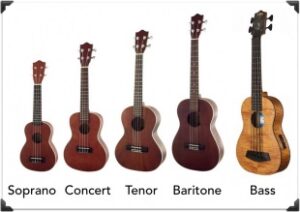
Ukuleles are small, four-stringed instruments that originated in Hawaii and are popular among many musicians. There are different types of ukuleles, each with its own characteristics and advantages. Here are some of the most common ones:
- Soprano: This is the smallest and most traditional type of ukulele, measuring about 21 inches in length. It has a bright and cheerful sound and is easy to play for beginners. However, it may not have enough volume or range for some players.
- Concert: This is a slightly larger and louder type of ukulele, measuring about 23 inches in length. It has a fuller and richer sound than the soprano, yet remains easy to handle and carry around. It is a good choice for intermediate players who want more versatility and expression.
- Tenor: This is a larger and deeper type of ukulele, measuring about 26 inches in length. It has a warm and resonant sound and offers more space for the fingers on the fretboard. It is suitable for advanced players who want more complexity and variety in their music.
- Baritone: This is the largest and lowest type of ukulele, measuring about 30 inches in length. It has a mellow and guitar-like sound, and is tuned differently from the other types of ukuleles. It is ideal for experienced players who want to explore different genres and styles of music.
- Bass: A bass ukulele is a type of stringed instrument that produces low-pitched sounds similar to a bass guitar. It usually has four nylon or metal strings that are tuned to E, A, D, and G, an octave lower than a regular ukulele. Bass ukuleles are often used to accompany other instruments in various musical genres, such as jazz, folk, and reggae.
These are some of the different types of ukuleles that you can choose from, depending on your preferences and goals. Ukuleles are fun and versatile instruments that can bring joy and creativity to your life.
Exploring the Soprano Ukulele
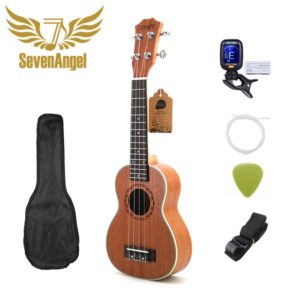
The soprano ukulele is the smallest and most common type of ukulele, with a standard tuning of G4-C4-E4-A4. It has a bright and cheerful sound that is ideal for strumming chords, playing melodies, and singing along. has a bright and cheerful sound that is suitable for many styles of music, such as folk, pop, jazz, and Hawaiian. The soprano ukulele is also easy to carry around and learn, making it a popular choice for beginners and enthusiasts alike.
The soprano ukulele has a typical length of 53 cm (21 inches) and a scale length of 33 cm (13 inches). The body shape can vary, but the most common ones are the figure-eight and the pineapple. The soprano ukulele usually has 12 to 15 frets, with some models having more or fewer. The fretboard can be made of various materials, such as rosewood, mahogany, or maple. The strings can be made of nylon, fluorocarbon, or metal.
The soprano ukulele is a versatile instrument that can be played solo or in a group. It can also be amplified with a pickup or a microphone. Some soprano ukuleles have built-in tuners, preamps, or effects. The soprano ukulele can be customised with different accessories, such as straps, capos, picks, or cases.
Unveiling the Concert Ukulele
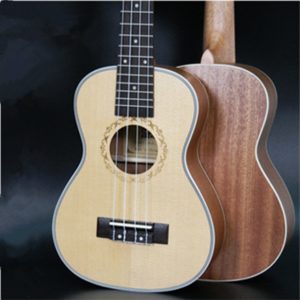
The concert ukulele is a musical instrument that belongs to the lute family. It is a smaller and more portable version of the guitar, with four nylon strings and a fretted fingerboard. The concert ukulele is one of the most popular types of ukuleles, as it offers a balanced sound, a comfortable size, and a wide range of musical possibilities.
The concert ukulele originated in Hawaii in the 19th century, when Portuguese immigrants brought their small guitars called machetes or braguinhas. The Hawaiians adapted these instruments to their own musical style and culture, and gave them the name ukulele, which means “jumping flea” in Hawaiian. The concert ukulele was developed in the 1920s as a larger and louder alternative to the soprano ukulele, which was the original and most common size.
The concert ukulele has a standard tuning of G-C-E-A, which is the same as the soprano ukulele, but it can also be tuned differently to suit different genres and preferences. The concert ukulele has a scale length of about 15 inches, which is the distance between the nut and the bridge. The concert ukulele also has more frets than the soprano ukulele, usually 15 to 20, which allows for more notes and chords to be played.
The concert ukulele is suitable for beginners and advanced players alike, as it is easy to learn and versatile to play. The concert ukulele can produce a warm and rich sound, with a bright and clear tone. The concert ukulele can be played solo or in a group, with or without accompaniment. The concert ukulele can also be amplified or plugged into an effects pedal to create different sounds and effects.
The concert ukulele is a great instrument for anyone who loves music and wants to express themselves creatively. The concert ukulele is a fun and affordable way to enjoy playing music, whether at home, at school, or on stage. The concert ukulele is a beautiful and unique instrument that can bring joy and happiness to anyone who plays it.
Diving into the Tenor Ukulele
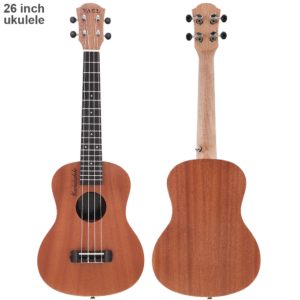
The tenor ukulele is one of the most popular and versatile types of ukuleles. It has a larger body and a longer scale length than the soprano and concert ukuleles, which gives it a richer and fuller sound. The tenor ukulele also has more frets, which allows for more range and complexity in playing. In this article, we will explore the history, features, advantages and disadvantages of the tenor ukulele, as well as some tips and tricks for beginners and advanced players alike.
A tenor ukulele is a type of ukulele that has a larger body and a longer scale length than the soprano and concert ukuleles. It typically has 17 to 19 frets and produces a deeper and louder sound than the smaller ukuleles. The tenor ukulele is popular among professional musicians and performers who want more volume and projection from their instrument. The tenor ukulele can be tuned in different ways, such as GCEA (standard), DGBE (baritone), or ADF#B (slack-key). Some tenor ukuleles have a low-G string instead of a high-G string, which gives them a wider range of notes and a richer tone. The tenor ukulele is suitable for playing various styles of music, such as folk, pop, jazz, blues, and Hawaiian.
Discovering the Baritone Ukulele
The baritone ukulele is a unique and versatile instrument that can enrich your musical repertoire. Unlike the more common soprano, concert and tenor ukuleles, the baritone ukulele has a deeper and richer sound that resembles a classical guitar. It also has a different tuning system, using the same notes as the top four strings of a guitar (D-G-B-E), instead of the standard ukulele tuning (G-C-E-A). This means that you can play many guitar chords and songs on the baritone ukulele without having to learn new fingerings.
The baritone ukulele is also larger than the other types of ukuleles, measuring about 30 inches in length and having a scale length of 19 inches. The longer scale length allows for more tension on the strings, which results in a louder and fuller sound. The larger size also makes the baritone ukulele more comfortable to play for people with bigger hands or longer fingers.
If you are interested in discovering the baritone ukulele, there are some things you should consider before buying one.
- First, you should decide what kind of music you want to play on it. The baritone ukulele is suitable for many genres, such as folk, blues, jazz, pop and even rock. However, if you are looking for a traditional Hawaiian sound, you might be better off with a smaller ukulele.
- Second, you should choose a quality instrument that suits your budget and preferences. There are many brands and models of baritone ukuleles available, ranging from cheap and cheerful to expensive and exquisite. You should look for a baritone ukulele that has a solid wood top, which will produce a better tone and volume than a laminate one. You should also pay attention to the craftsmanship, the hardware, the strings and the accessories that come with the instrument.
- Third, you should learn how to play and maintain your baritone ukulele properly. You can find many online resources, such as videos, tutorials, books and courses, that can teach you the basics of playing the baritone ukulele. You should also tune your instrument regularly, change your strings when they wear out, and clean and store your instrument in a safe place.
The baritone ukulele is a wonderful instrument that can offer you many musical possibilities. By choosing the right one for you, learning how to play it well and taking good care of it, you can enjoy its beautiful sound for years to come.
The Bass Ukulele
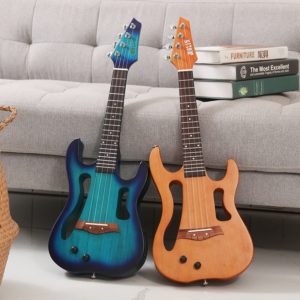
The bass ukulele is a musical instrument that combines the features of a bass guitar and a ukulele. It has four strings, usually tuned to the same notes as a standard bass guitar (E-A-D-G), but with a shorter scale length and a smaller body. The bass ukulele produces a low-pitched sound that can complement the higher-pitched sound of a regular ukulele. Bass ukuleles are often used in genres such as reggae, folk, pop, and rock.
Bass ukuleles can be either acoustic or electric. Acoustic bass ukuleles have a hollow body that resonates with the sound of the strings, while electric bass ukuleles have a solid body that requires an amplifier to produce sound. Some electric bass ukuleles also have pickups that can modify the tone and volume of the instrument. Bass ukuleles can be played with fingers, picks, or thumb picks, depending on the preference of the player and the style of music.
Unique Ukulele Styles and Variations
The ukulele is a versatile instrument that can produce a variety of sounds and styles. Depending on the size, shape, tuning, and playing technique of the ukulele, it can create different musical effects and moods. Some of the most common ukulele styles and variations are:
- Hawaiian: This is the traditional style of playing the ukulele, which originated in Hawaii in the late 19th century. It involves strumming the strings with the index finger or a felt pick, and using a vibrato technique called “kaholo”. Hawaiian ukulele music is often accompanied by singing and features melodies that are influenced by Polynesian, European, and American folk music.
- Jazz: This is a style of playing the ukulele that incorporates elements of jazz music, such as swing rhythms, syncopation, chords, and improvisation. Jazz ukulele players often use fingerpicking or plectrum techniques, and experiment with different tunings and scales. Jazz ukulele music can range from smooth and mellow to upbeat and lively.
- Classical: This is a style of playing the ukulele that follows the rules and conventions of classical music, such as harmony, structure, and notation. Classical ukulele players usually use nylon strings and fingerpicking techniques, and play solo or in ensemble settings. Classical ukulele music can include adaptations of works by composers such as Bach, Mozart, and Beethoven, as well as original compositions.
- Rock: This is a style of playing the ukulele that draws inspiration from rock music genres, such as pop, punk, metal, and alternative. Rock ukulele players often use steel strings and strumming or picking techniques, and add effects such as distortion, reverb, and delay. Rock ukulele music can be energetic and loud, or soft and melodic.
- Folk: This is a style of playing the ukulele that reflects the traditions and cultures of various regions and countries. Folk ukulele players often use simple strumming or fingerpicking patterns and sing along with their instruments. Folk ukulele music can include songs from genres such as country, blues, reggae, bluegrass, and flamenco.
Choosing the Right Ukulele for Your Playing Style
Ukuleles are versatile and fun instruments that can suit different playing styles and musical genres. However, not all ukuleles are created equal, and choosing the right one for your needs can make a big difference in your sound and comfort. In this article, we will explore some factors to consider when selecting a ukulele for your playing style, such as size, shape, wood type, strings, tuning, and accessories.
- Size: Ukuleles come in four main sizes: soprano, concert, tenor, and baritone. The size affects the tone, volume, and playability of the instrument. Generally, smaller ukuleles have a brighter and softer sound, while larger ones have a deeper and louder sound. Smaller ukuleles are also easier to hold and carry, but they may have less fret space and string tension than larger ones. Therefore, you should choose a size that matches your preference and comfort level.
- Shape: Ukuleles can have different body shapes, such as pineapple, guitar, cutaway, or resonator. The shape influences the resonance and projection of the sound, as well as the aesthetics of the instrument. Some shapes may also offer more access to the upper frets or more stability on your lap. You should choose a shape that appeals to your taste and suits your playing style.
- Wood type: Ukuleles can be made from various types of wood, such as mahogany, koa, spruce, cedar, or rosewood. The wood type affects the tone, durability, and appearance of the instrument. Different woods have different tonal qualities, such as warm, bright, mellow, or crisp. They also have different grain patterns, colours, and finishes that can enhance the beauty of the ukulele. You should choose a wood type that matches your desired sound and look.
- Strings: Ukuleles can have different types of strings, such as nylon, fluoropolymers (carbon), or steel. The strings affect the tone, feel, and tuning stability of the instrument. Nylon strings are the most common and traditional choice for ukuleles. They have a soft and warm sound and a smooth feel. Fluorocarbon strings are similar to nylon but have a brighter and louder sound and a stiffer feel. Metal strings are rare and usually used for baritone ukuleles. They have a metallic and resonant sound and a rough feel. You should choose strings that suit your preference and playing style.
- Tuning: Ukuleles can have different tunings, such as standard (GCEA), low G (GCEA with a lower G string), baritone (DGBE), or alternative (such as ADF#B or DGBD). The tuning affects the range, chord shapes, and melodies of the instrument. Standard tuning is the most common and versatile choice for ukuleles. It offers a balanced range of notes and easy chord shapes. Low G tuning is similar to standard but with a lower G string that adds more bass notes and depth to the sound. Baritone tuning is the same as the top four strings of a guitar and gives a deeper and richer sound. Alternative tunings can create different sounds and moods for your music. You should choose a tuning that fits your musical goals and style.
- Accessories: Ukuleles can benefit from various accessories that can enhance their performance and maintenance. Some examples are tuners, straps, cases, picks, capos, stands, humidifiers, or amplifiers. Tuners help you keep your ukulele in tune and play in tune with others. Straps help you hold your ukulele securely and comfortably. Cases protect your ukulele from damage and dust when not in use or when travelling. Picks help you pluck or strum the strings with more force or precision. Capos help you change the key of your songs without changing the chord shapes. Stands help you display or store your ukulele safely when not in use. Humidifiers help you prevent your ukulele from cracking or warping due to dryness or humidity changes. Amplifiers help you amplify your sound when playing in larger venues or with other instruments.
Choosing the right ukulele for your playing style can be a rewarding and enjoyable process that can improve your musical experience. By considering factors such as size, shape, wood type, strings, tuning, and accessories, you can find a ukulele that suits your needs and preferences.
Conclusion to Types and Styles of the Ukulele
The ukulele is a versatile and expressive instrument that comes in different types and styles. The five main types are soprano, concert, tenor, baritone and bass, each with its own size, tuning and sound. The style of the ukulele can vary depending on the shape of the body, the material of the wood, the type of strings and the design of the sound hole. Some common styles are pineapple, banjo, resonator and electric ukuleles. By choosing the right type and style of ukulele for your musical preferences and goals, you can enjoy playing this fun and beautiful instrument for years to come.
